The Discrete and Continuous Retardation and Relaxation Spectrum Method for Viscoelastic Characterization of Warm Mix Crumb Rubber-Modified Asphalt Mixtures
Abstract
1. Introduction
2. Materials and Methods
2.1. Materials and Specimen Fabrication
2.2. Experimental Plan
3. Theoretical Background
3.1. LVE Theory Asphalt Mixtures
3.1.1. The Time-Temperature Superposition Principle (TTSP)
3.1.2. The Method of Construction the Master Curve of Linear Viscoelastic Response Function
The Master Curve of Dynamic Modulus and Phase Angle
The Master Curve of Storage Modulus and Loss Modulus
The Master Curve of Storage Compliance and Loss Compliance
3.2. Determine the Discrete Relaxation Spectrum and Retardation Spectrum
3.2.1. Determine the Discrete Relaxation Spectrum
3.2.2. Determine the Discrete Retardation Spectrum
3.3. Determine the Continuous Relaxation Spectrum and Retardation Spectrum
3.3.1. Determine the Continuous Relaxation Spectrum
3.3.2. Determine the Continuous Retardation Spectrum
4. Results and Discussion
4.1. Characterization of LVE Behavior of Crumb Rubber-modified Asphalt Mixtures
4.2. Relaxation Spectrum and Retardation Spectrum of Asphalt Mixture
4.2.1. The Discrete Relaxation Spectrum and Retardation Spectrum of Asphalt Mixture
4.2.2. The Continuous Relaxation Spectrum and Retardation Spectrum of Asphalt Mixture
4.2.3. Compared the Discrete and Continuous Relaxation Spectrum and Retardation Spectrum of Asphalt Mixture
- (1)
- The complex modulus test carried out in temperature of 5 °C–50 °C, and there are some errors in the test. The higher the temperature, the greater the error.
- (2)
- We used the approximate K-K relations rather than the exact K-K relations. In addition, the GSM constructed from the test results tend to show larger errors at extremely low and high frequencies.
- (3)
- In the process of using the Prony series to calculate the discrete spectrum, the discrete time is pre-selected, and the discrete spectrum intensity is obtained by the optimization algorithm, but it is a multi-solution problem, although we set constraints during the optimization process.
4.3. Construction of Master Curves Relaxation Modulus and Creep Compliance
4.3.1. The Relaxation Modulus and Creep Compliance Obtained from the Discrete Spectrum
4.3.2. The Relaxation Modulus and Creep Compliance Obtained from the Continuous Spectrum
4.3.3. Compared Relaxation Modulus and Creep Compliance Obtained the Discrete and Continuous Spectrum
5. Conclusions
- (1)
- According to the complex modulus test data of four types of mixtures, the master curve models of storage modulus and loss modulus are developed according to the approximate K-K relations. These master curve models share the same model parameters and allow for possible asymmetry. Similarly, the master curve model of storage compliance and loss compliance is also developed according to the approximate K-K relations.
- (2)
- The continuous and discrete relaxation spectrum can be obtained from the storage modulus master curves utilizing integral transformations and the collocation method, respectively. Similarly, the continuous and discrete retardation spectrum can be obtained from the storage compliance master curve.
- (3)
- The shape of the discrete spectrum is similar to that of the continuous spectrum. The most significant difference is the intensity of the discrete spectrum is higher than that of the continuous spectrum.
- (4)
- The relaxation modulus and creep compliance were calculated by the discrete and continuous spectrum, respectively. The difference between the discrete and continuous spectrum is negligible in the time domain of 10−5 s-103 s. However, there are significant differences outside the region.
- (5)
- HMA-60 has a better deformation capacity than HMA-C at a shorter reduced time and a worse deformation resistance than HMA-C at a longer reduced time. Moreover, the deformation capacity of WMA-60 is better than WMA-C at a shorter reduced time, and a worse deformation resistance than WMA-C is seen at a longer reduced time. Once the warm mix additive was added, the mixture’s deformation capacity was improved at a shorter reduced time. Moreover, improved the deformation resistance in longer reduced time.
Supplementary Materials
Author Contributions
Funding
Acknowledgments
Conflicts of Interest
Appendix A
| Temperature/°C | Coefficients Variation of Dynamic Modulus/% | ||||||||
|---|---|---|---|---|---|---|---|---|---|
| 0.1 Hz | 0.5 Hz | 1 Hz | 5 Hz | 10 Hz | 20 Hz | 25 Hz | Average | ||
| HMA-60 | 5 | 3.5 | 3.9 | 4.6 | 4.9 | 5.7 | 5.7 | 6.5 | 4.97 |
| 20 | 5.1 | 5.6 | 6.4 | 8.3 | 8.5 | 9.5 | 8.7 | 7.44 | |
| 35 | 10.4 | 11.3 | 11.5 | 11.6 | 12.4 | 14.2 | 15.9 | 12.47 | |
| 50 | 12.8 | 12.8 | 13.9 | 14.6 | 15.4 | 16.9 | 16.8 | 14.74 | |
| WMA-60 | 5 | 4.1 | 4.6 | 5 | 5.2 | 4.9 | 5.6 | 6.7 | 5.16 |
| 20 | 4.8 | 5.3 | 6.7 | 7.9 | 7.8 | 9.5 | 10.6 | 7.51 | |
| 35 | 9.9 | 10.6 | 13.4 | 11.1 | 14.8 | 14.5 | 17.2 | 13.07 | |
| 50 | 11.4 | 12.9 | 14.6 | 14.8 | 15.3 | 16.2 | 17.3 | 14.64 | |
| HMA-C | 5 | 3.2 | 4.9 | 6.2 | 5.5 | 7.1 | 6.9 | 10.4 | 6.31 |
| 20 | 5.6 | 5.1 | 6.7 | 7.9 | 9.3 | 10.9 | 12.4 | 8.27 | |
| 35 | 9.9 | 11.3 | 10.7 | 10.4 | 11.6 | 10.9 | 13.7 | 11.21 | |
| 50 | 11.9 | 13.5 | 12.4 | 11.7 | 12.8 | 12.7 | 14.5 | 12.79 | |
| WMA-C | 5 | 4.5 | 5.5 | 4.4 | 5.1 | 5.7 | 6.3 | 8.7 | 5.74 |
| 20 | 6.3 | 5.2 | 7.1 | 7.5 | 9.2 | 8.5 | 10.8 | 7.80 | |
| 35 | 9.9 | 11.3 | 10.9 | 10.4 | 11.7 | 13.8 | 15.1 | 11.87 | |
| 50 | 11.5 | 11.8 | 12.9 | 13.7 | 12.4 | 11.8 | 15.9 | 12.86 | |
| Temperature/°C | Coefficients Variation of Phase Angle/% | ||||||||
|---|---|---|---|---|---|---|---|---|---|
| 0.1 Hz | 0.5 Hz | 1 Hz | 5 Hz | 10 Hz | 20 Hz | 25 Hz | Average | ||
| HMA-60 | 5 | 5.6 | 6.2 | 7.1 | 7.8 | 8.2 | 9.2 | 10.3 | 7.77 |
| 20 | 11.5 | 12 | 13.4 | 14.2 | 15.3 | 16.7 | 17.5 | 14.37 | |
| 35 | 16.1 | 17.6 | 17.2 | 20.3 | 21.7 | 20.9 | 22.3 | 19.44 | |
| 50 | 18.5 | 21.6 | 20.4 | 19.8 | 22.3 | 21.5 | 20.8 | 20.70 | |
| WMA-60 | 5 | 6 | 6.8 | 7.3 | 7.5 | 8.3 | 8.9 | 9.9 | 7.81 |
| 20 | 10.4 | 11.6 | 12.8 | 13.9 | 15.7 | 15.9 | 18 | 14.04 | |
| 35 | 15.3 | 16.7 | 17.3 | 19.9 | 19.4 | 20.3 | 21.1 | 18.57 | |
| 50 | 17.6 | 20.5 | 20.6 | 18.9 | 19.8 | 22 | 21.5 | 20.13 | |
| HMA-C | 5 | 6.3 | 6.8 | 7.0 | 8.3 | 8.8 | 9.1 | 10.6 | 8.13 |
| 20 | 10.7 | 11.7 | 12.9 | 13.5 | 14.9 | 15.7 | 16.5 | 13.70 | |
| 35 | 15.4 | 16.8 | 17.2 | 20.5 | 21.2 | 20.6 | 21.8 | 19.07 | |
| 50 | 17.9 | 21.4 | 20.3 | 18.9 | 21.7 | 20.5 | 22.1 | 20.40 | |
| WMA-C | 5 | 4.5 | 5.5 | 6.1 | 6.9 | 8.4 | 8.6 | 9.7 | 7.10 |
| 20 | 10.3 | 11.2 | 12.1 | 13.5 | 14.2 | 15.5 | 16.8 | 13.37 | |
| 35 | 15.4 | 16.9 | 18.2 | 17.6 | 20.4 | 20.3 | 21.6 | 18.63 | |
| 50 | 16.9 | 20.7 | 22.7 | 20.8 | 21.5 | 20.9 | 21.5 | 20.71 | |


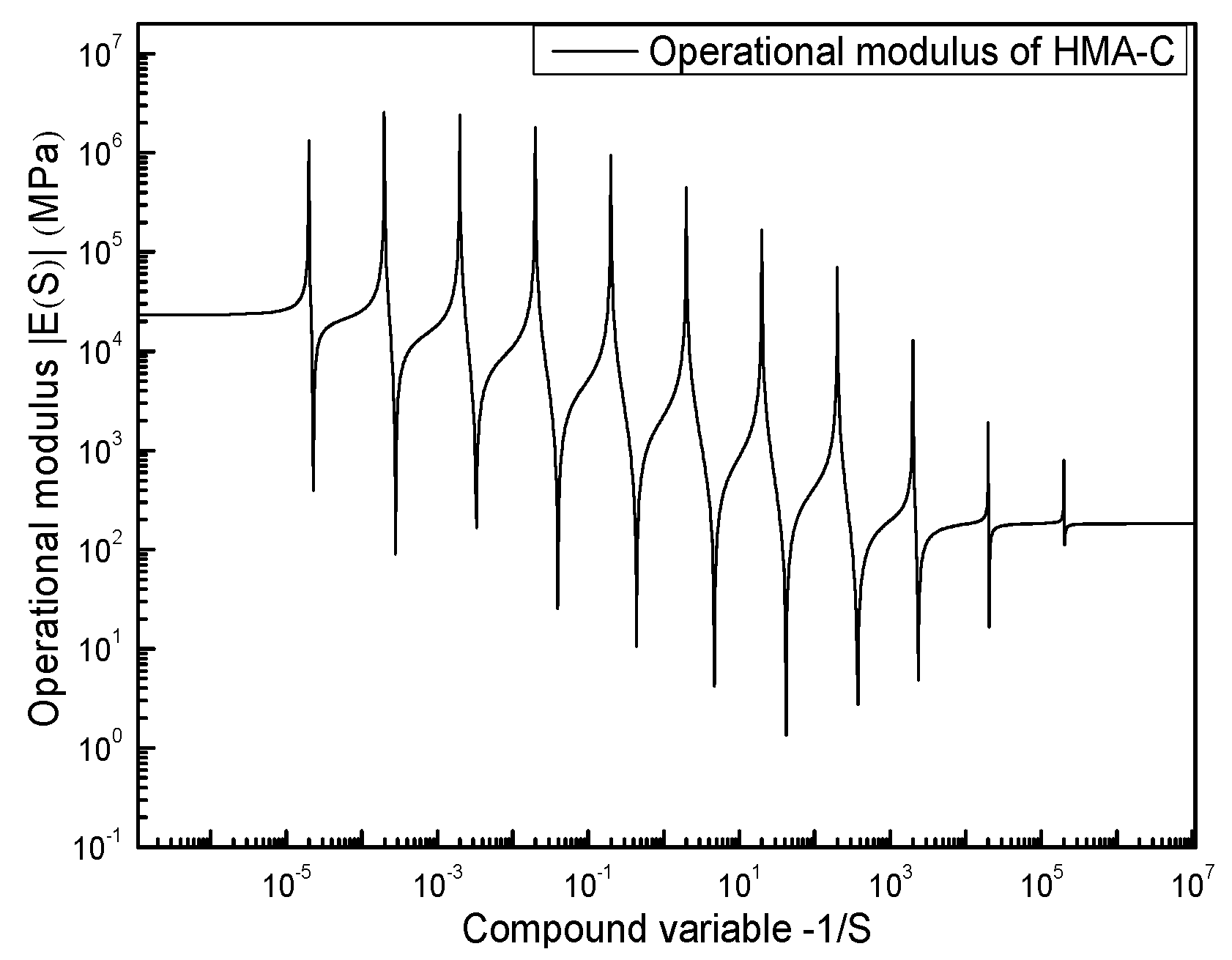
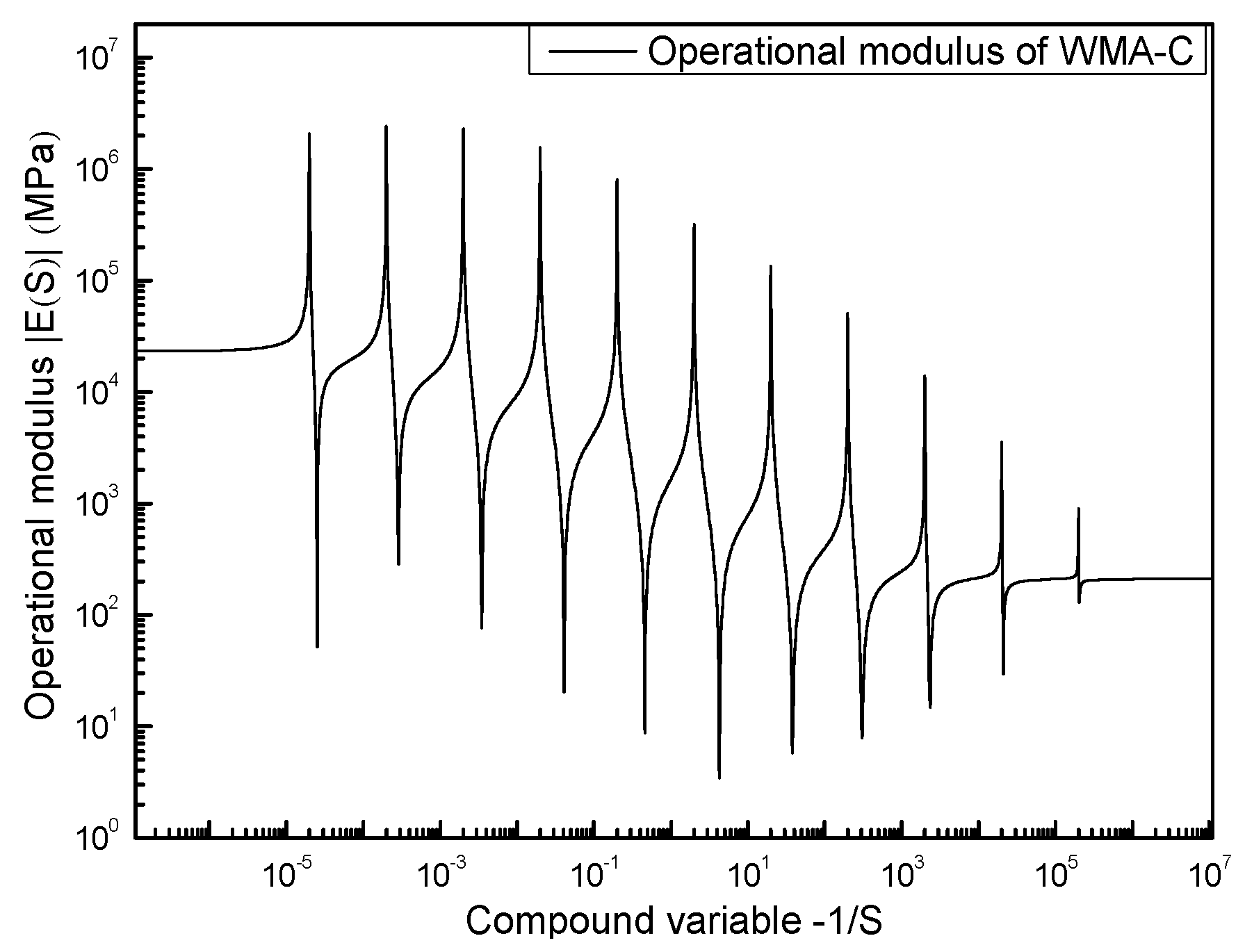
| i | HMA-60 | WMA-60 | HMA-C | WMA-C | ||||
|---|---|---|---|---|---|---|---|---|
| ρi | Ei | ρi | Ei | ρi | Ei | ρi | Ei | |
| 1 | 0.00002 | 3852.1 | 0.00002 | 2650.0 | 0.00002 | 3087.9 | 0.00002 | 4910.2 |
| 2 | 0.0002 | 5434.5 | 0.0002 | 4580.1 | 0.0002 | 5998.5 | 0.0002 | 5693.3 |
| 3 | 0.002 | 6061.5 | 0.002 | 5233.2 | 0.002 | 5665.0 | 0.002 | 5464.6 |
| 4 | 0.02 | 3680.0 | 0.02 | 3208.0 | 0.02 | 4254.5 | 0.02 | 3717.2 |
| 5 | 0.2 | 1751.0 | 0.2 | 1476.5 | 0.2 | 2239.5 | 0.2 | 1920.1 |
| 6 | 2 | 566.5 | 2 | 610.9 | 2 | 1054.3 | 2 | 758.0 |
| 7 | 20 | 223.2 | 20 | 271.7 | 20 | 394.9 | 20 | 318.4 |
| 8 | 200 | 35.8 | 200 | 105.4 | 200 | 165.9 | 200 | 120.9 |
| 9 | 2000 | 11.8 | 2000 | 40.4 | 2000 | 30.0 | 2000 | 32.8 |
| 10 | 20,000 | 5.3 | 20,000 | 10.1 | 20,000 | 4.1 | 20,000 | 7.91 |
| 11 | 200,000 | 1.9 | 200,000 | 1.2 | 200,000 | 1.5 | 200,000 | 1.65 |
| Ee = 121.58 | Ee = 193.10 | Ee = 183.34 | Ee = 209.75 | |||||
| i | HMA-60 | WMA-60 | HMA-C | WMA-C | ||||
|---|---|---|---|---|---|---|---|---|
| τj | Dj | τj | Dj | τj | Dj | τj | Dj | |
| 1 | 0.000024 | 5.70 × 10−5 | 0.000023 | 5.69 × 10−7 | 0.000023 | 4.97 × 10−6 | 0.000025 | 8.82 × 10−6 |
| 2 | 0.000282 | 3.12 × 10−5 | 0.00028 | 2.79 × 10−5 | 0.00028 | 2.01 × 10−5 | 0.00029 | 2.32 × 10−5 |
| 3 | 0.00372 | 5.46 × 10−5 | 0.00363 | 6.83 × 10−5 | 0.00331 | 4.00 × 10−5 | 0.00347 | 5.04 × 10−5 |
| 4 | 0.0447 | 1.66 × 10−4 | 0.0427 | 1.55 × 10−4 | 0.0398 | 1.04 × 10−4 | 0.0407 | 1.24 × 10−4 |
| 5 | 0.55 | 3.94 × 10−4 | 0.437 | 3.45 × 10−4 | 0.437 | 2.41 × 10−4 | 0.457 | 2.91 × 10−4 |
| 6 | 5.1 | 1.05 × 10−4 | 4.07 | 7.66 × 10−4 | 4.68 | 6.04 × 10−4 | 4.27 | 6.74 × 10−4 |
| 7 | 49.0 | 2.01 × 10−3 | 36.3 | 1.23 × 10−3 | 41.7 | 1.32 × 10−3 | 38 | 1.23 × 10−3 |
| 8 | 263.0 | 3.00 × 10−3 | 295 | 1.60 × 10−3 | 372 | 1.43 × 10−3 | 309 | 1.21 × 10−3 |
| 9 | 2150.0 | 1.66 × 10−3 | 2400 | 1.01 × 10−3 | 2340 | 1.01 × 10−3 | 2340 | 3.28 × 10−4 |
| 10 | 20,900 | 2.68 × 10−4 | 20,900 | 3.34 × 10−3 | 20,400 | 2.94 × 10−4 | 20,900 | 1.00 × 10−4 |
| 11 | 204,000 | 1.70 × 10−5 | 204,000 | 3.94 × 10−5 | 204,000 | 5.94 × 10−6 | 204,000 | 2.47 × 10−6 |
| Dg = 4.60 × 10−5 | Dg = 5.4 × 10−5 | Dg = 4.33 × 10−5 | Dg = 4.41 × 10−5 | |||||
References
- Kim, Y.R.; Little, D.N.; Lytton, R.L. Fatigue and healing characterization of asphalt mixtures. J. Mater. Civ. Eng. 2003, 15, 75–83. [Google Scholar] [CrossRef]
- Park, S.W.; Schapery, R.A. Methods of interconversion between linear viscoelastic material functions. Part I—A numerical method based on Prony series. Int. J. Solids Struct. 1999, 36, 1653–1675. [Google Scholar] [CrossRef]
- Alavi, S.M.Z. Comprehensive Methodologies for Analysis of Thermal Cracking in Asphalt Concrete Pavements; University of Nevada: Reno, NV, USA, 2014; ISBN 9781321216097. [Google Scholar]
- Tschoegl, N.W. The Phenomenological Theory of Linear Viscoelastic Behavior: An Introduction; Springer: New York, NY, USA, 1989; ISBN 9783642736025. [Google Scholar]
- Esposito, M.; Sorrentino, L.; Krejčí, P.; Davino, D. Modeling of a Visco-Hyperelastic Polymeric Foam with a Continuous to Discrete Relaxation Spectrum Approach. J. Mech. Phys. Solids 2020, 104030. [Google Scholar] [CrossRef]
- Xu, Q.; Prozzi, J.A. Static versus viscoelastic wave propagation approach for simulating loading effects on flexible pavement structure. Constr. Build. Mater. 2014, 53, 584–595. [Google Scholar] [CrossRef]
- Zhao, Y.; Ni, Y.; Zeng, W. A consistent approach for characterising asphalt concrete based on generalised Maxwell or Kelvin model. Road Mater. Pavement Des. 2014, 15, 674–690. [Google Scholar] [CrossRef]
- Schapery, R.A. A Simple Collocation Method for Fitting Viscoelastic Models to Experimental Data; California Institute of Technology: Pasadena, CA, USA, 1962. [Google Scholar]
- Sari, M.S.; Butcher, E.A. Free vibration analysis of rectangular and annular Mindlin plates with undamaged and damaged boundaries by the spectral collocation method. J. Vib. Control. 2012, 18, 1722–1736. [Google Scholar] [CrossRef]
- Cost, T.L.; Becker, E.B. A multidata method of approximate Laplace transform inversion. Int. J. Numer. Methods Eng. 1970, 2, 207–219. [Google Scholar] [CrossRef]
- Emri, I.; Tschoegl, N.W. Generating line spectra from experimental responses. Part I: Relaxation modulus and creep compliance. Rheol. Acta 1993, 32, 311–322. [Google Scholar] [CrossRef]
- Emri, I.; Tschoegl, N.W. Determination of mechanical spectra from experimental responses. Int. J. Solids Struct. 1995, 32, 817–826. [Google Scholar] [CrossRef]
- Emri, I.; Tschoegl, N.W. Generating line spectra from experimental responses. Part IV: Application to experimental data. Rheol. Acta 1994, 33, 60–70. [Google Scholar] [CrossRef]
- Park, S.W.; Kim, Y.R. Fitting Prony-series viscoelastic models with power-law presmoothing. J. Mater. Civ. Eng. 2001, 13, 26–32. [Google Scholar] [CrossRef]
- Ramkumar, D.H.S.; Caruthers, J.M.; Mavridis, H. Computation of the linear viscoelastic relaxation spectrum from experimental data. J. Appl. Polym. Sci. 1997, 64, 2177–2189. [Google Scholar] [CrossRef]
- Mustapha, S.S.; Phillips, T.N. A dynamic nonlinear regression method for the determination of the discrete relaxation spectrum. J. Phys. DAppl. Phys. 2000, 33, 1219. [Google Scholar] [CrossRef][Green Version]
- Hansen, S. Estimation of the relaxation spectrum from dynamic experiments using Bayesian analysis and a new regularization constraint. Rheol. Acta 2008, 47, 169–178. [Google Scholar] [CrossRef]
- Stadler, F.J.; Bailly, C. A new method for the calculation of continuous relaxation spectra from dynamic-mechanical data. Rheol. Acta 2009, 48, 33–49. [Google Scholar] [CrossRef]
- Bae, J.E.; Cho, K.S. A systematic approximation of discrete relaxation time spectrum from the continuous spectrum. J. Non-Newton. Fluid Mech. 2016, 235, 64–75. [Google Scholar] [CrossRef]
- Martinetti, L.; Soulages, J.M.; Ewoldt, R.H. Continuous relaxation spectra for constitutive models in medium-amplitude oscillatory shear. J. Rheol. 2018, 62, 1271–1298. [Google Scholar] [CrossRef]
- Bažant, Z.P.; Xi, Y. Continuous retardation spectrum for solidification theory of concrete creep. J. Eng. Mech. 1995, 121, 281–288. [Google Scholar] [CrossRef]
- Mun, S.; Zi, G. Modeling the viscoelastic function of asphalt concrete using a spectrum method. Mech. Time-Depend. Mater. 2010, 14, 191–202. [Google Scholar] [CrossRef]
- Sun, Y.; Chen, J.; Huang, B. Characterization of asphalt concrete linear viscoelastic behavior utilizing Havriliak–Negami complex modulus model. Constr. Build. Mater. 2015, 99, 226–234. [Google Scholar] [CrossRef]
- Liu, H.; Luo, R.; Lv, H. Establishing continuous relaxation spectrum based on complex modulus tests to construct relaxation modulus master curves in compliance with linear viscoelastic theory. Constr. Build. Mater. 2018, 165, 372–384. [Google Scholar] [CrossRef]
- Katsourinis, S.; Kontou, E. Comparing interconversion methods between linear viscoelastic material functions. Mech. Time-Depend. Mater. 2018, 22, 401–419. [Google Scholar] [CrossRef]
- Gu, L.; Chen, L.; Zhang, W.; Ma, H. Mesostructural Modeling of Dynamic Modulus and Phase Angle Master Curves of Rubber Modified Asphalt Mixture. Materials 2019, 12, 1667. [Google Scholar] [CrossRef] [PubMed]
- Yu, D.; Yu, X.; Gu, Y. Establishment of linkages between empirical and mechanical models for asphalt mixtures through relaxation spectra determination. Constr. Build. Mater. 2020, 242, 118095. [Google Scholar] [CrossRef]
- Teltayev, B.B.; Amirbayev, E.D.; Radovskiy, B.S. Viscoelastic characteristics of blown bitumen at low temperatures. Constr. Build. Mater. 2018, 189, 54–61. [Google Scholar] [CrossRef]
- Liu, H.; Zeiada, W.; Al-Khateeb, G.G.; Shanableh, A.; Samarai, M. A framework for linear viscoelastic characterization of asphalt mixtures. Mater. Struct. 2020, 53, 1–15. [Google Scholar] [CrossRef]
- Zeiada, W.A.; Gudipudi, P.P.; Underwood, B.S.; Souliman, M.I. Effect of Loading Waveform Pattern and Rest Period on Fatigue Life of Asphalt Concrete Using Viscoelastic Continuum Damage Model. Transp. Res. Record 2018, 2672, 451–461. [Google Scholar] [CrossRef]
- Baglieri, O.; Tsantilis, L.; Santagata, E. Evaluation of healing potential of bituminous binders using a viscoelastic continuum damage approach. Constr. Build. Mater. 2018, 184, 344–350. [Google Scholar] [CrossRef]
- Bueno, L.D.; Schuster, S.L.; Specht, L.P. Asphalt pavement design optimisation: A case study using viscoelastic continuum damage theory. Int. J. Pavement Eng. 2020, 1–13. [Google Scholar] [CrossRef]
- Kassem, H.; Chehab, G.; Najjar, S. Development of probabilistic viscoelastic continuum damage model for asphalt concrete. Transp. Res. Record. 2019, 2673, 285–298. [Google Scholar] [CrossRef]
- Sadek, H.; Sadeq, M.; Masad, E.; Khalid, H.A. Probabilistic Viscoelastic Continuum Damage Analysis of Fatigue Life of Warm-Mix Asphalt. J. Transp. Eng. B Pavements 2019, 145, 04019024. [Google Scholar] [CrossRef]
- Zhao, Y.; Chen, P.; Cao, D. Extension of modified Havriliak-Negami model to characterize linear viscoelastic properties of asphalt binders. J. Mater. Civ. Eng. 2016, 28, 04015195. [Google Scholar] [CrossRef]
- Yatabe, Z.; Muramatsu, T.; Asubar, J.T.; Kasai, S. Calculating relaxation time distribution function from power spectrum based on inverse integral transformation method. Phys. Lett. A 2015, 379, 738–742. [Google Scholar] [CrossRef]
- Wang, H.; Li, X.; Xiao, J.; You, Z.; Yang, X.; Irfan, M. High-Temperature Performance and Workability of Crumb Rubber–Modified Warm-Mix Asphalt. J. Test. Eval. 2020, 48. [Google Scholar] [CrossRef]
- Standard Method of Test for Determining the Dynamic Modulus and Flow Number for Asphalt Mixture Using the Asphalt Mixture Performance Tester; American Association of State Highway and Transportation Officials: Washington, DC, USA, 2015.
- Jaczewski, M.; Judycki, J.; Jaskula, P. Asphalt concrete subjected to long-time loading at low temperatures–Deviations from the time-temperature superposition principle. Constr. Build. Mater. 2019, 202, 426–439. [Google Scholar] [CrossRef]
- Williams, M.L.; Landel, R.F.; Ferry, J.D. The temperature dependence of relaxation mechanisms in amorphous polymers and other glass-forming liquids. J. Am. Chem. Soc. 1955, 77, 3701–3707. [Google Scholar] [CrossRef]
- Rowe, G.M.; Khoee, S.H.; Blankenship, P.; Mahboub, K.C. Evaluation of aspects of E* test by using hot-mix asphalt specimens with varying void contents. Transp. Res. Record 2009, 2127, 164–172. [Google Scholar] [CrossRef]
- Rowe, G. Phase Angle Determination and Interrelationships within Bituminous Materials 7th International RILEM Symposium on Advanced Testing and Characterization of Bituminous Materials; Taylor & Francis Group: London, UK, 2009; Volume 1, pp. 43–52. ISBN 9780415558563. [Google Scholar]
- Barra, B.; Momm, L.; Guerrero, Y.; Al-Qureshi, H.A. Temperature implications on rheological-mechanical behavior and design of high modulus dense asphalt mix. Constr. Build. Mater. 2016, 125, 135–144. [Google Scholar] [CrossRef]
- Zbiciak, A.; Michalczyk, R.; Brzeziński, K. Time–temperature superposition for viscoelastic materials with application to asphalt–aggregate mixes. Int. J. Environ. Sci. Technol. 2019, 16, 5059–5064. [Google Scholar] [CrossRef]
- Tschoegl, N.W. Time dependence in material properties: An overview. Mech. Time-Depend. Mater. 1997, 1, 3–31. [Google Scholar] [CrossRef]
- Gurtovenko, A.A.; Gotlib, Y.Y. Viscoelastic dynamic properties of meshlike polymer networks: Contributions of intra-and interchain relaxation processes. Macromolecules 2000, 33, 6578–6587. [Google Scholar] [CrossRef]
- Gundla, A. Understanding Viscoelastic Behavior of Asphalt Binders through Molecular Structure Investigation; Arizona State University: Phoenix, AZ, USA, 2018; ISBN 9780438297258. [Google Scholar]
- Naderi, K.; Nejad, F.M.; Khodaii, A. Characterizing the aging of asphaltic materials through the evolution of continuous relaxation spectrum. Pet. Sci. Technol. 2019, 37, 2404–2411. [Google Scholar] [CrossRef]
- Mead, D.W. Determination of molecular weight distributions of linear flexible polymers from linear viscoelastic material functions. J. Rheol. 1994, 38, 1797–1827. [Google Scholar] [CrossRef]
- Findley, W.N.; Davis, F.A. Creep and Relaxation of Nonlinear Viscoelastic Materials; Dover Publication INC.: New York, NY, USA, 1989; ISBN 0486660168. [Google Scholar]
- Zhao, K.; Wang, Y.; Chen, L. Diluting or dissolving? The use of relaxation spectrum to assess rejuvenation effects in asphalt recycling. Constr. Build. Mater. 2018, 143–152. [Google Scholar] [CrossRef]
- Yu, D.; Gu, Y.; Yu, X. Rheological-microstructural evaluations of the short and long-term aged asphalt binders through relaxation spectra determination. Fuel 2020, 265, 116953. [Google Scholar] [CrossRef]
- Bhattacharjee, S.; Swamy, A.K.; Daniel, J.S. Continuous relaxation and retardation spectrum method for viscoelastic characterization of asphalt concrete. Mech. Time-Depend. Mater. 2012, 16, 287–305. [Google Scholar] [CrossRef]
- Kim, J.; Sholar, G.A.; Kim, S. Determination of accurate creep compliance and relaxation modulus at a single temperature for viscoelastic solids. J. Mater. Civ. Eng. 2008, 20, 14–156. [Google Scholar] [CrossRef]
- Sheikhmotevali, A.H.; Ameri, M. Application of bitumen rheological parameters to predict thermal cracking behavior of polymer modified asphalt mixture. Constr. Build. Mater. 2014, 66, 259–267. [Google Scholar] [CrossRef]
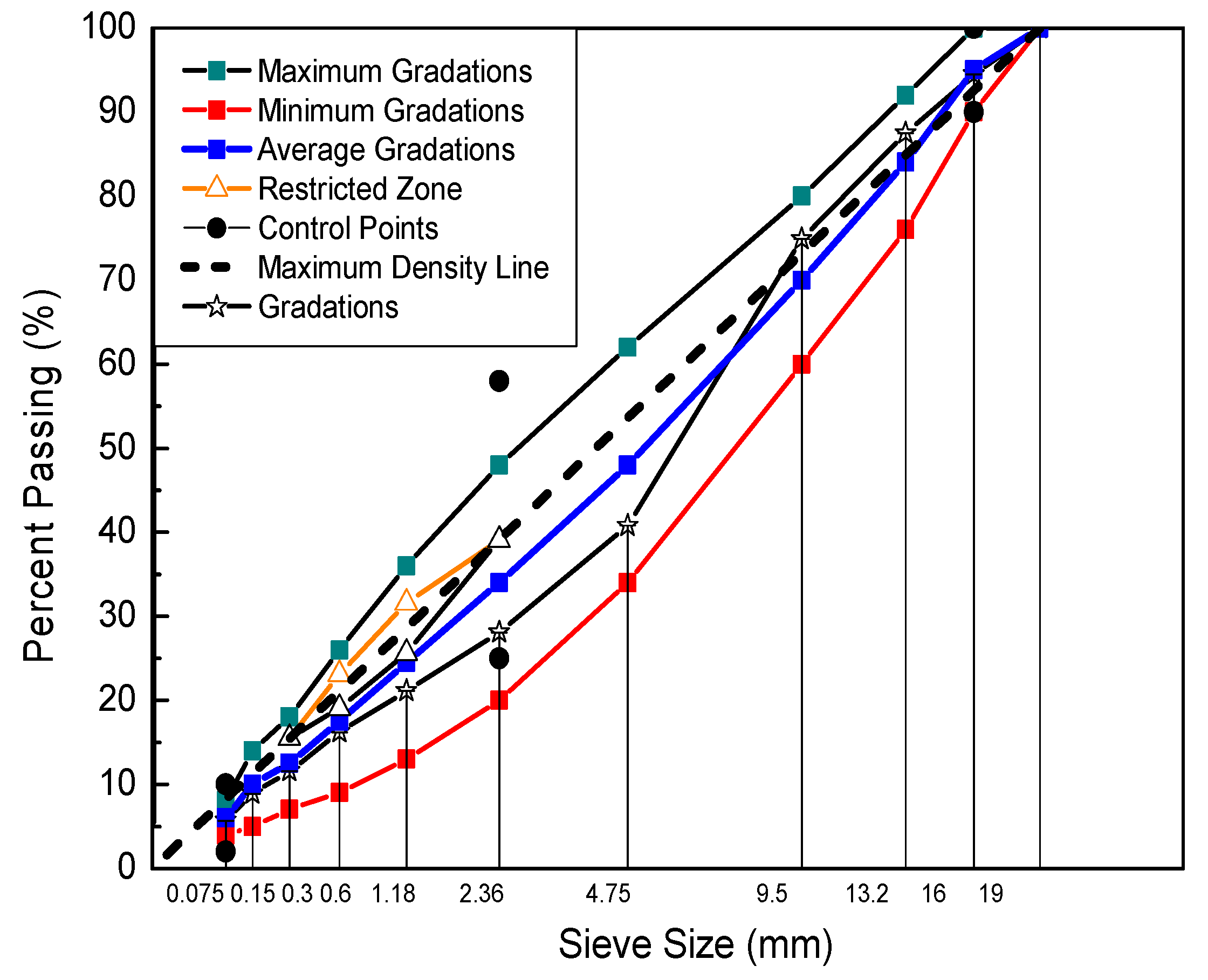
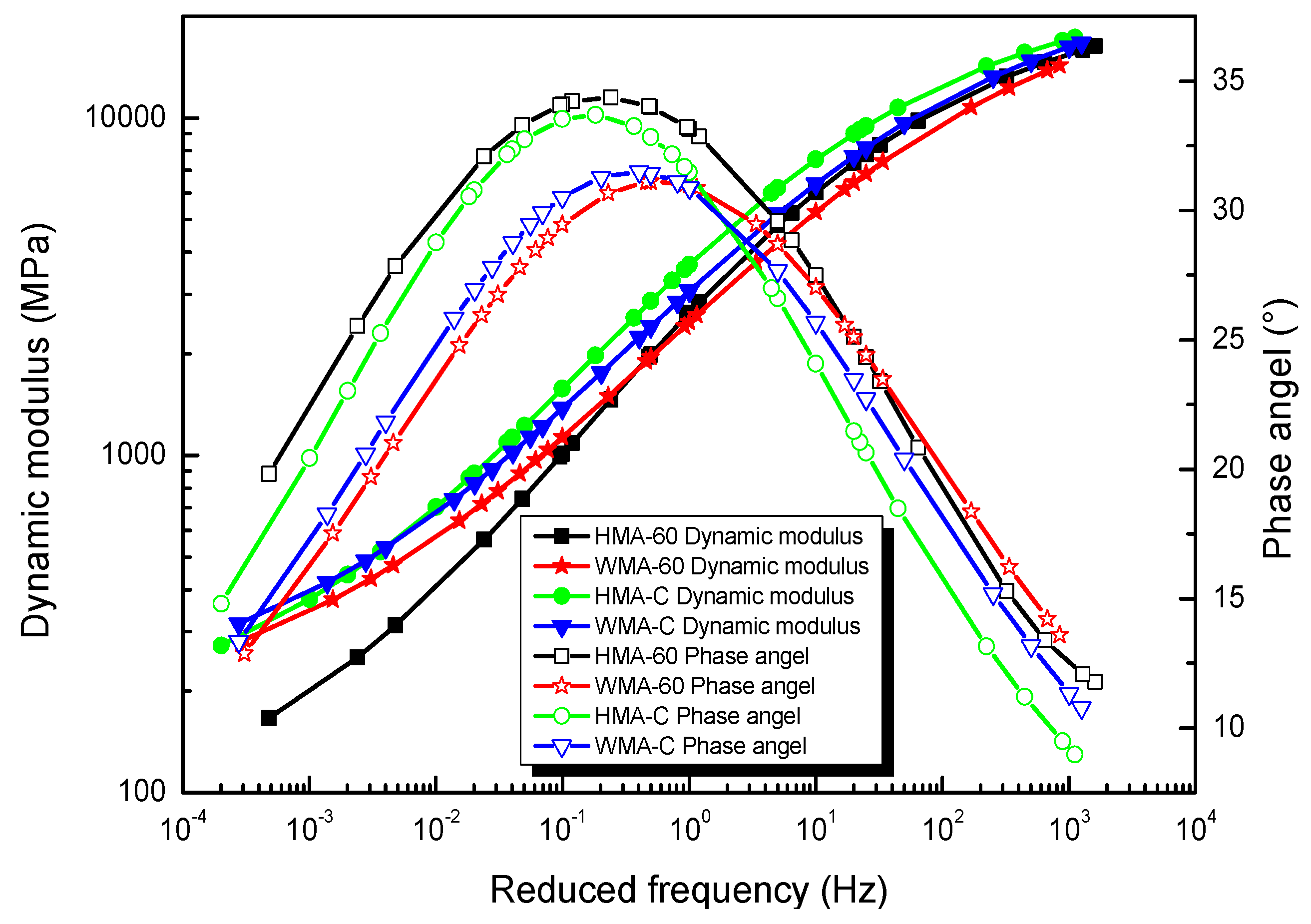
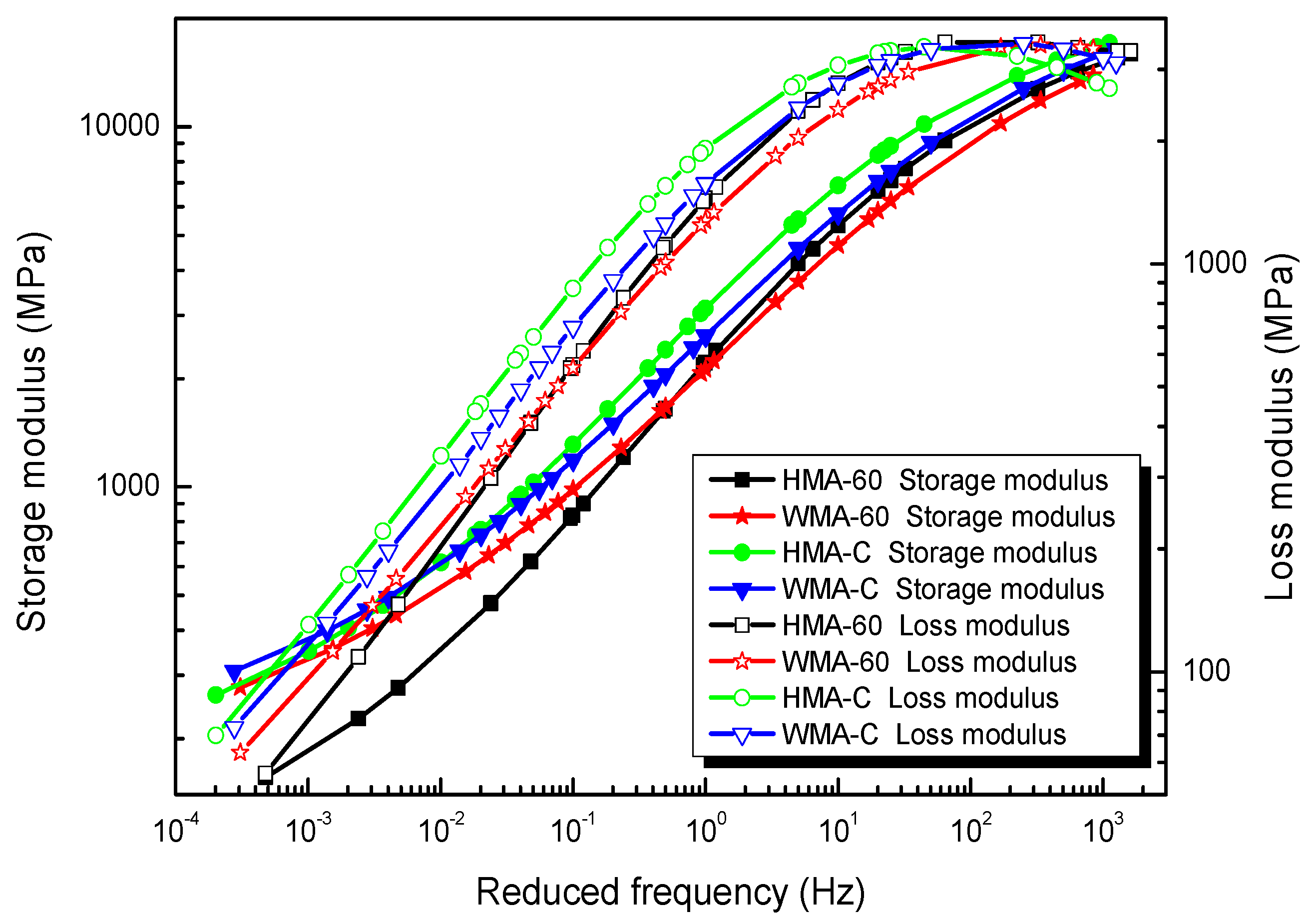
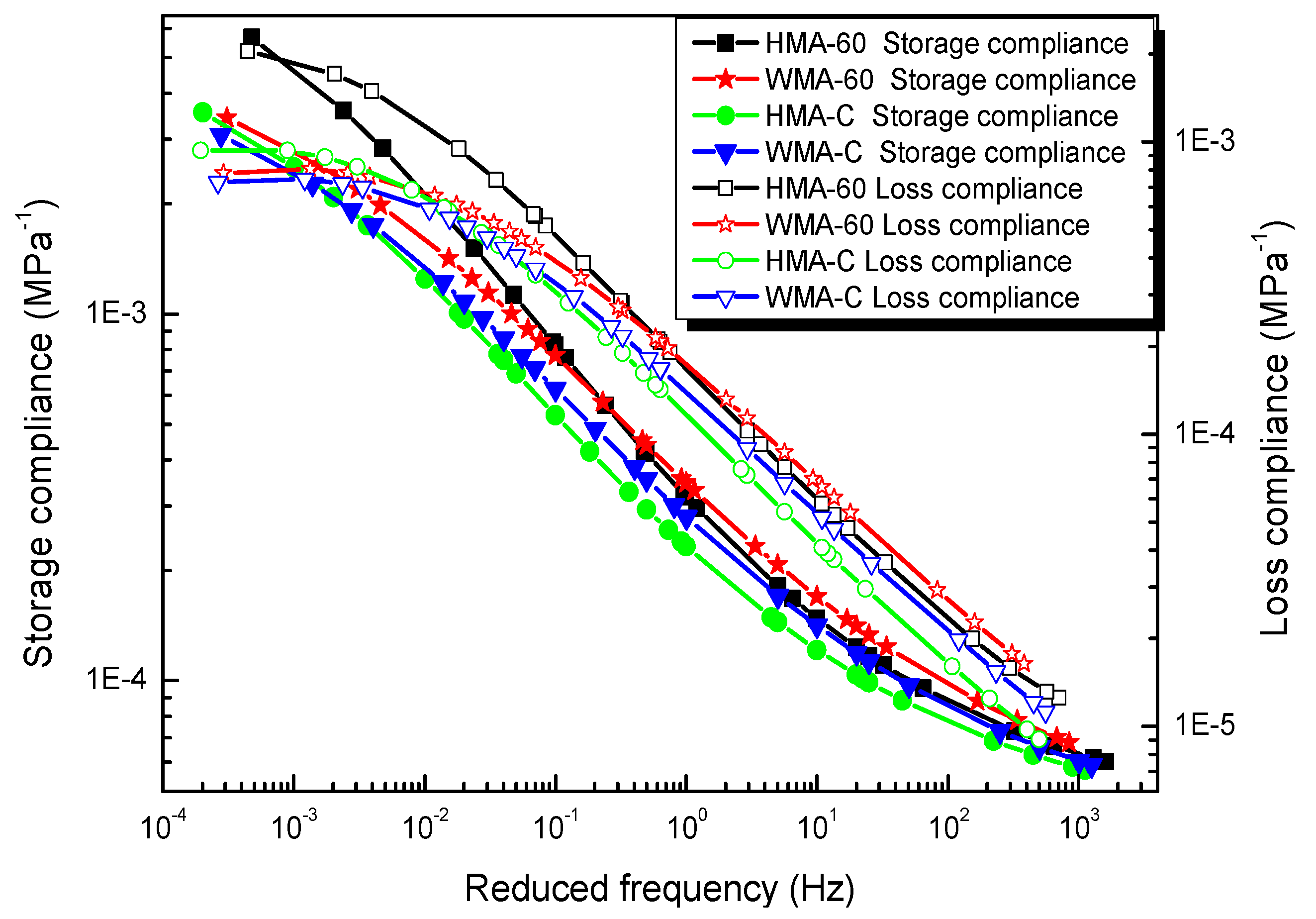
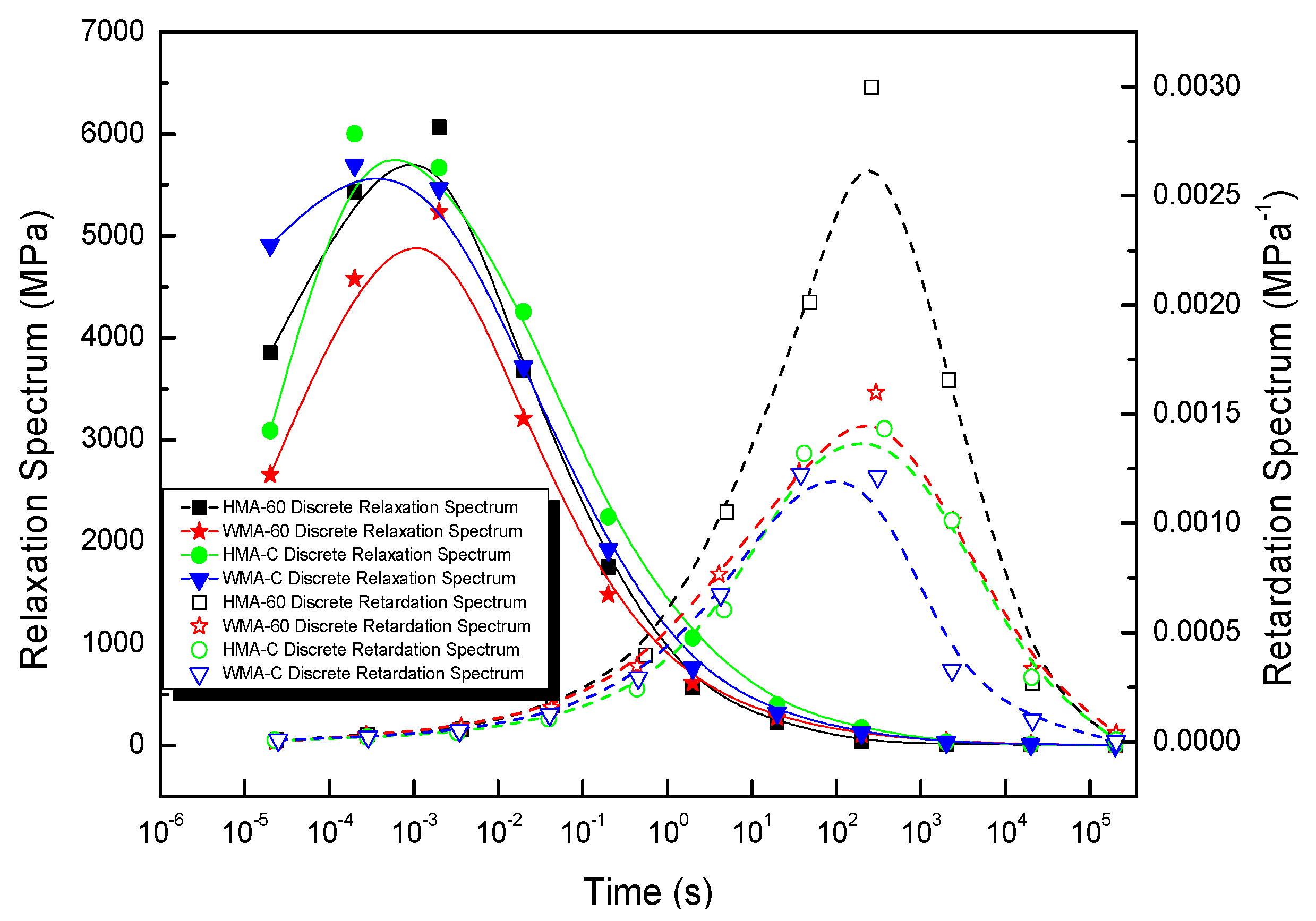
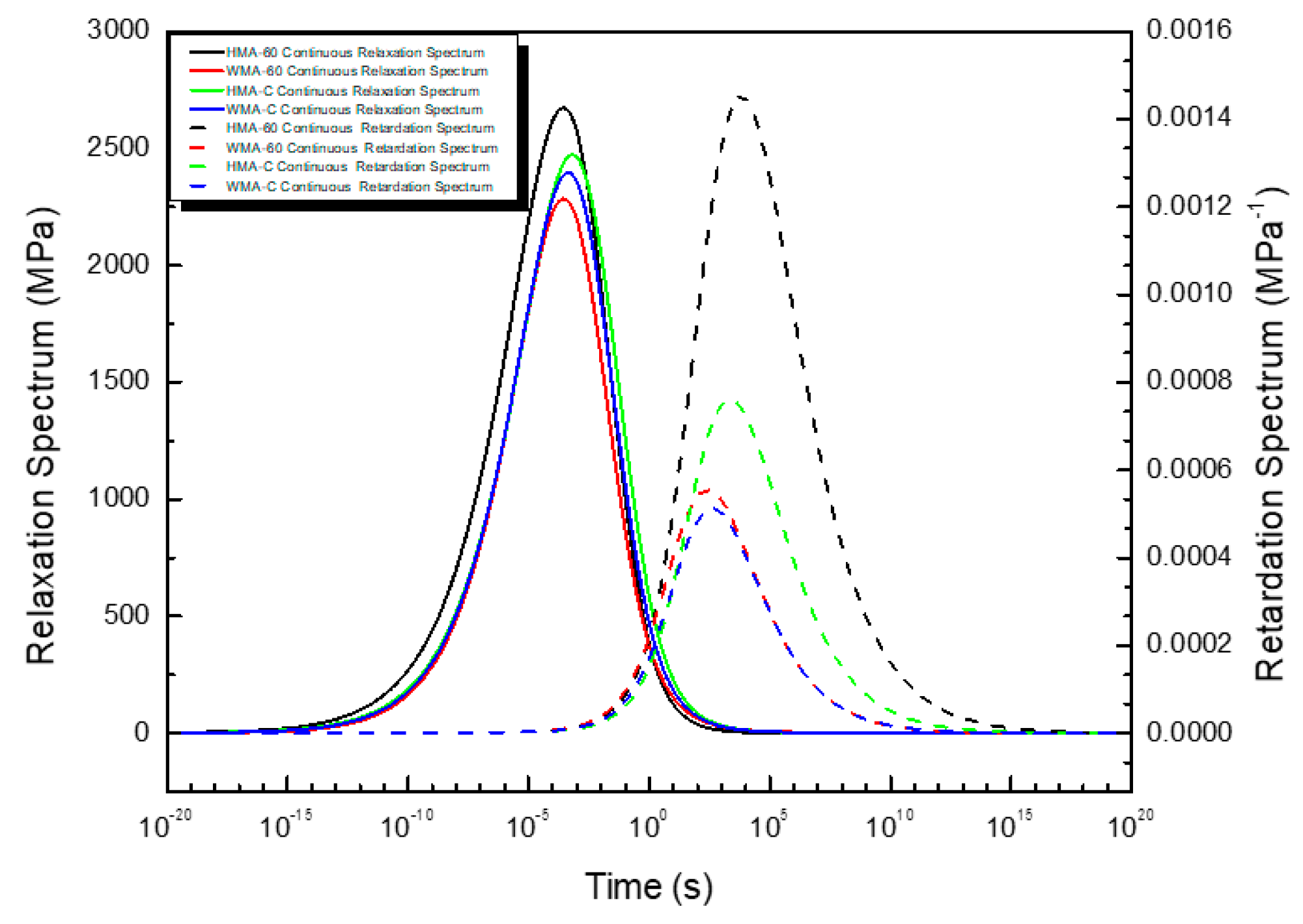

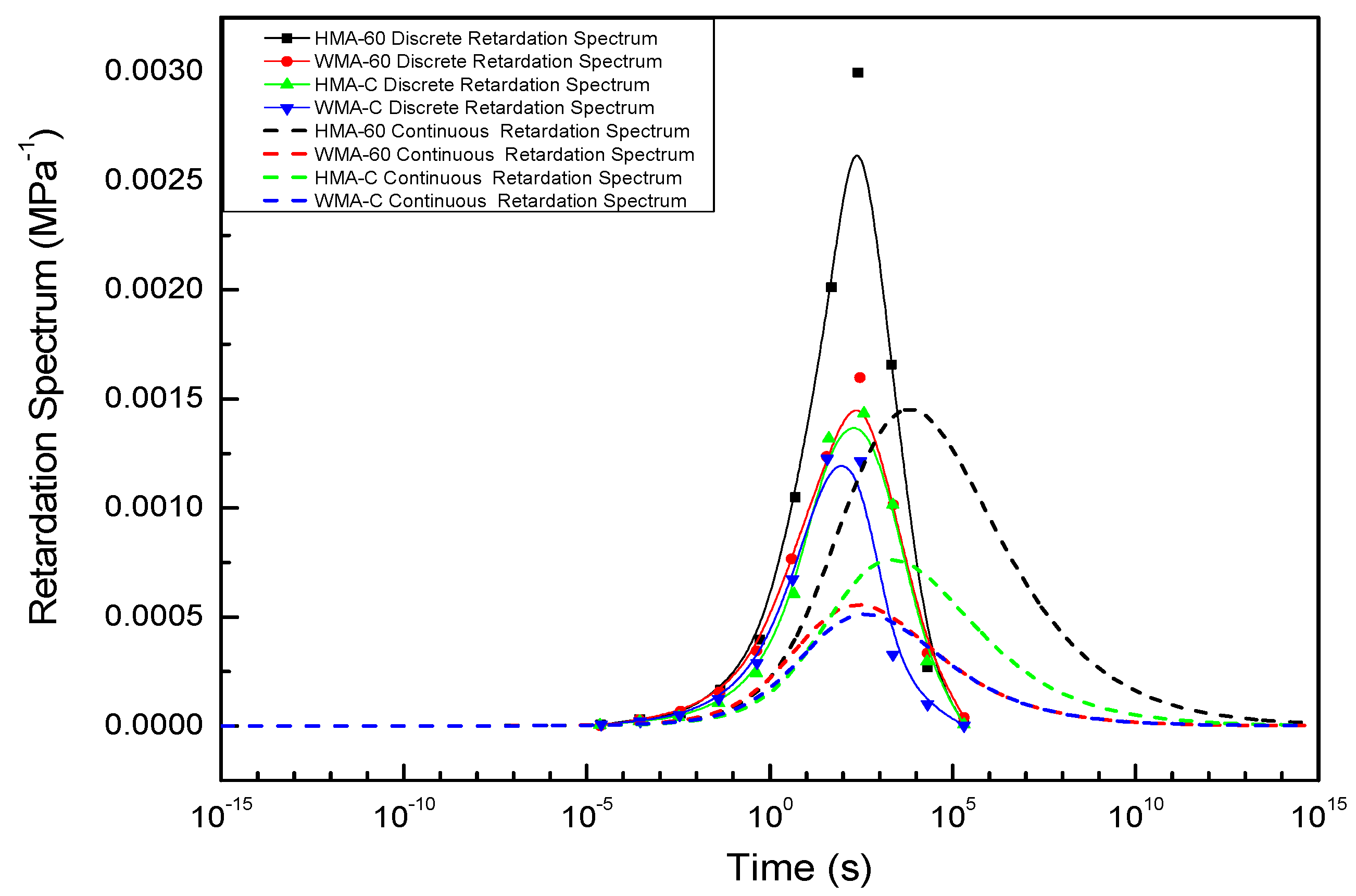
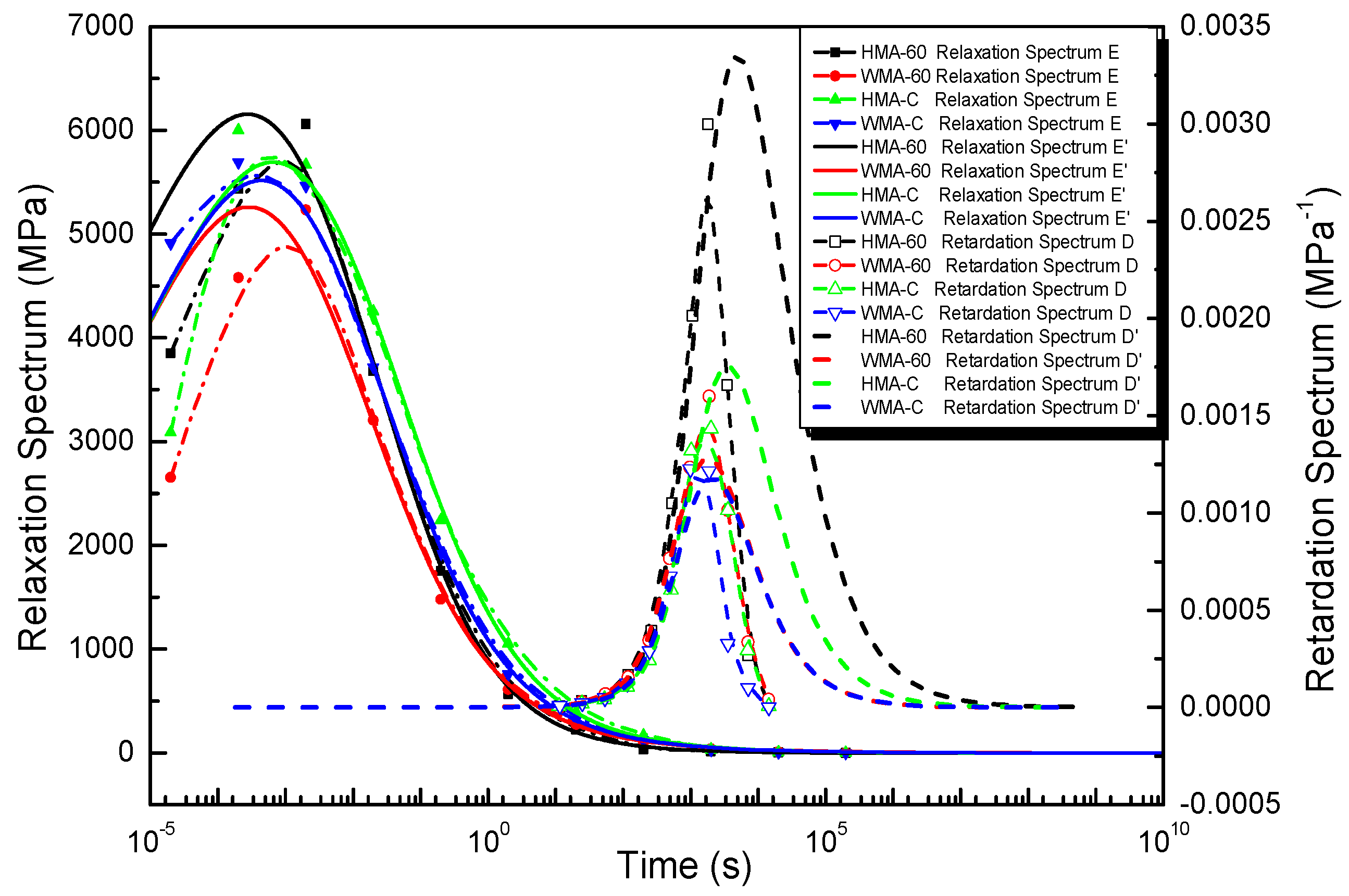
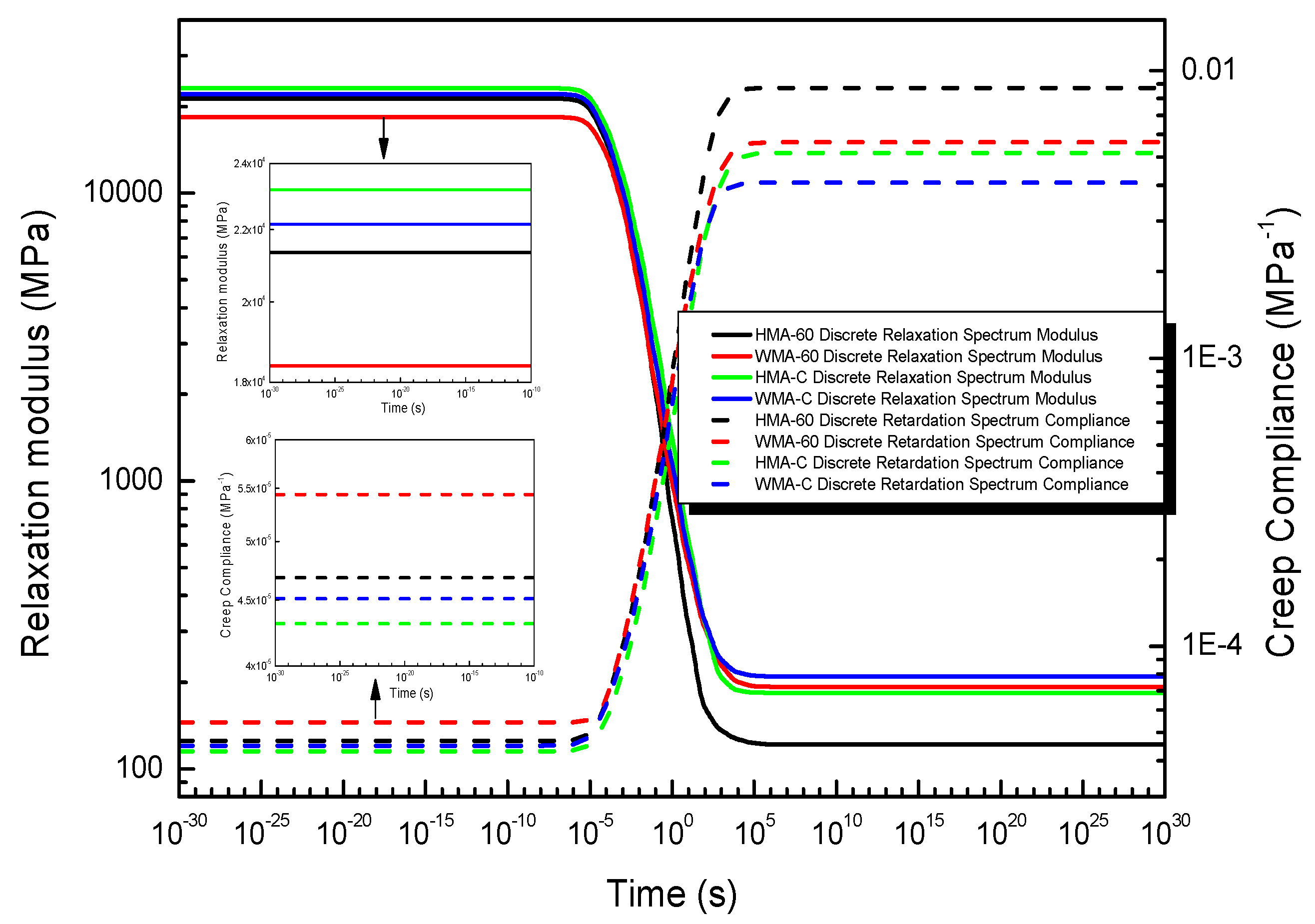

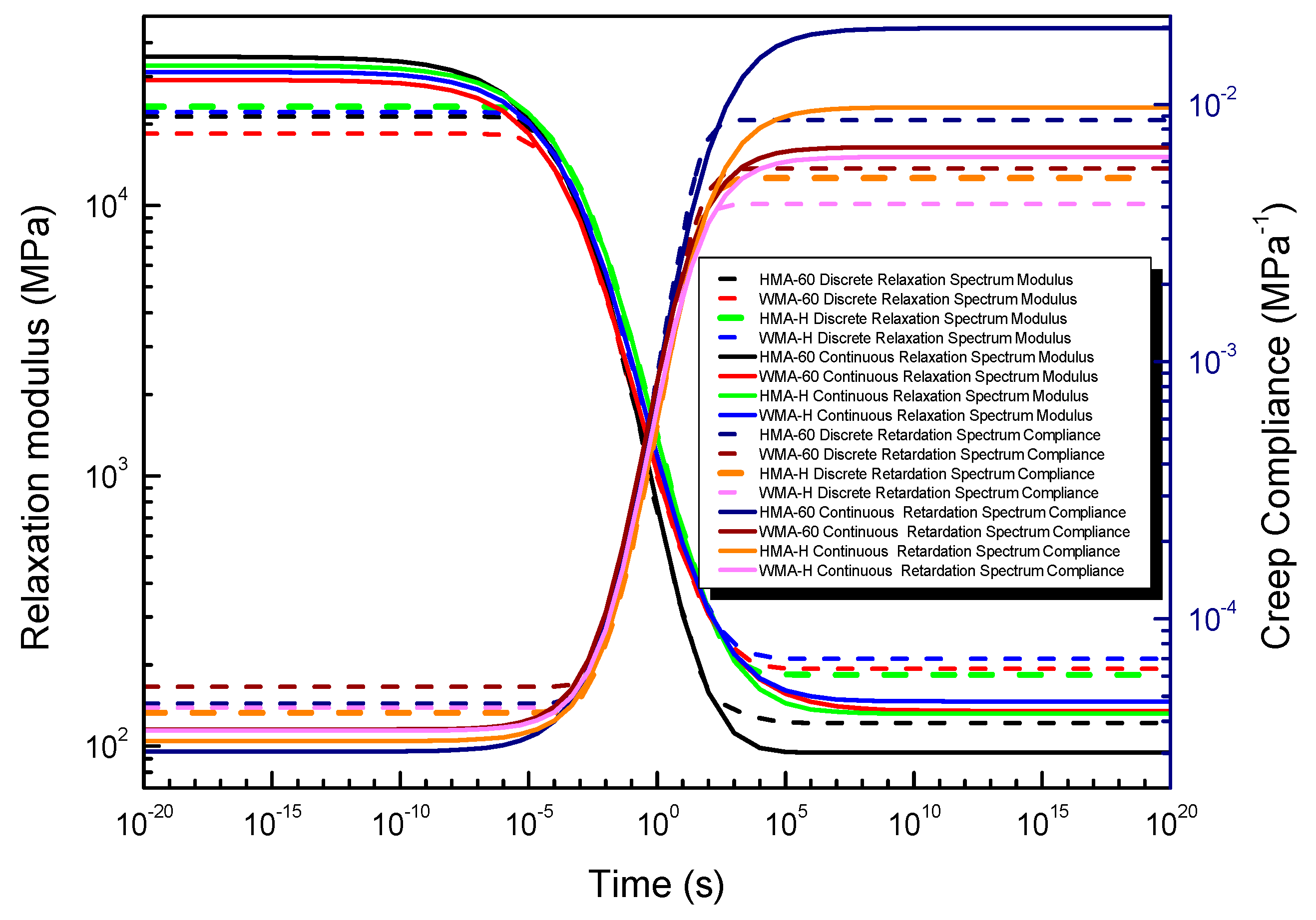
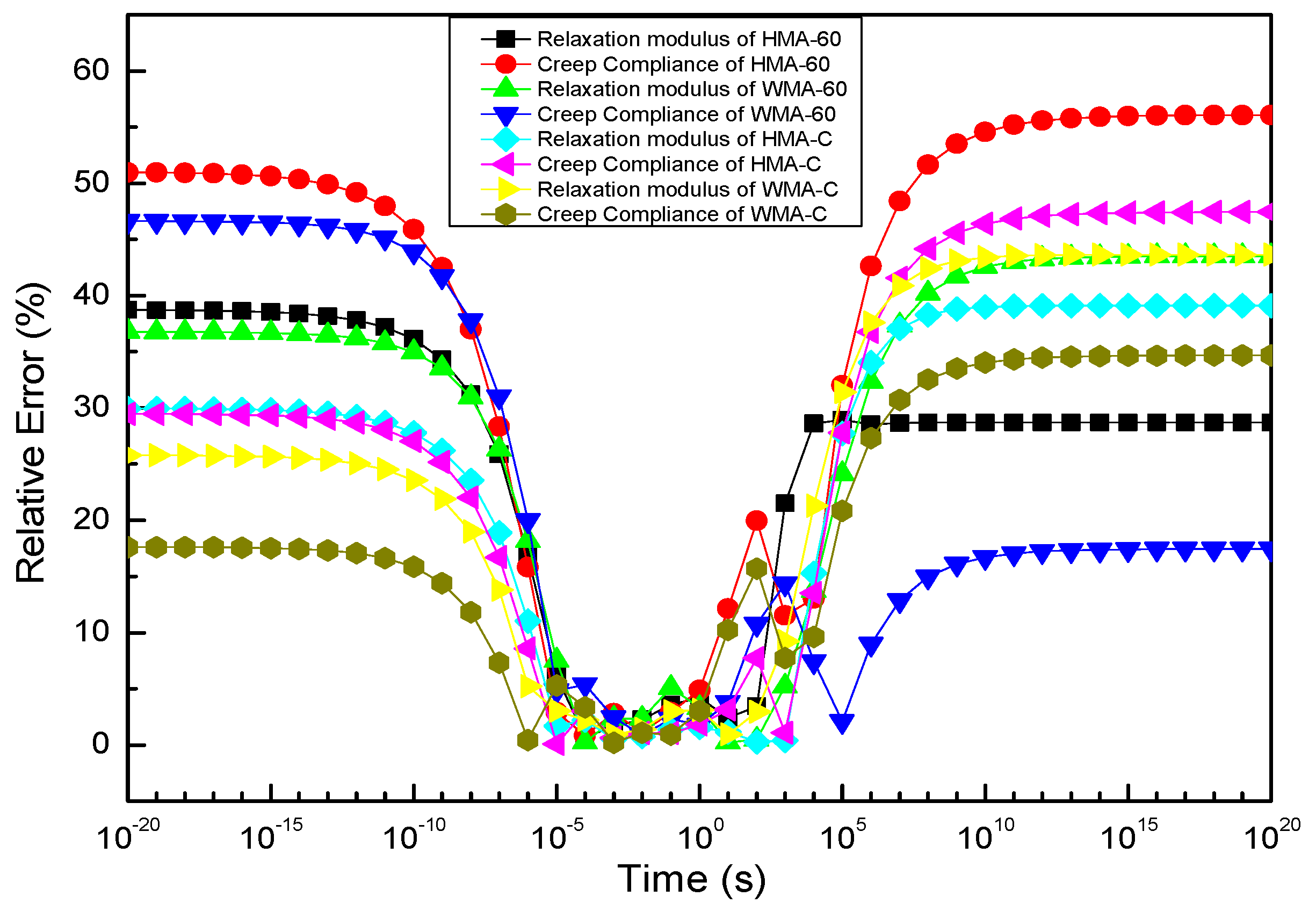
| Aggregate | 10–20 mm | 5–10 mm | 3–5 mm | 0–3 mm | Filler |
|---|---|---|---|---|---|
| Blend Percentage by Weight/% | 21 | 38 | 10 | 28 | 3 |
| Sample | Softening Point/°C | ||
|---|---|---|---|
| Bottom | Top | Difference | |
| H-CR-60 | 63.5 | 57.0 | 6.5 |
| W-CR-60 | 60.8 | 56.2 | 4.6 |
| H-CR-C | 68.1 | 59.8 | 8.3 |
| W-CR-C | 62.9 | 57.5 | 5.4 |
| Asphalt Mixture | OAC/% | Gross Density g/cm3 | Theoretical Density g/cm3 | Void/% | VMA/% | VFA/% | Stability/KN | Flow Value/mm |
|---|---|---|---|---|---|---|---|---|
| HMA-60 | 5.4 | 2.439 | 2.537 | 3.86 | 14.04 | 72.5 | 10.45 | 2.74 |
| WMA-60 | 5.4 | 2.442 | 2.538 | 3.78 | 13.93 | 72.8 | 10.95 | 2.87 |
| HMA-C | 5.6 | 2.441 | 2.546 | 4.12 | 14.15 | 70.9 | 11.23 | 2.45 |
| WMA-C | 5.6 | 2.444 | 2.546 | 4.01 | 14.04 | 71.5 | 11.61 | 2.62 |
| Standard | - | - | - | 3~5 | ≥13 | 65~75 | ≥8 | 2~4 |
| Mixture Type | Parameters | Error/% | |||||||
|---|---|---|---|---|---|---|---|---|---|
| δ | α | β | γ | λ | C1 | C2 | k | ||
| HMA-60 | 1.62 | 2.84 | −0.60 | −0.56 | 0.80 | 8.93 | 87.75 | 0.90 | 1.23 |
| WMA-60 | 2.29 | 2.13 | −0.14 | −0.62 | 0.81 | 19.14 | 202.14 | 0.97 | 0.83 |
| HMA-C | 2.12 | 2.40 | −0.54 | −0.51 | 0.51 | 19.13 | 187.95 | 0.98 | 0.81 |
| WMA-C | 2.33 | 2.14 | −0.31 | −0.56 | 0.52 | 14.02 | 138.11 | 1.01 | 0.75 |
| Mixture Type | Parameters | Error/% | |||||||
|---|---|---|---|---|---|---|---|---|---|
| δ′ | α′ | β′ | γ′ | λ′ | C1 | C2 | k′ | ||
| HMA-60 | 1.98 | 2.57 | −0.36 | −0.51 | 0.22 | 8.93 | 87.75 | 1.00 | 1.12 |
| WMA-60 | 2.13 | 2.33 | −0.12 | −0.58 | 0.92 | 19.14 | 202.14 | 1.00 | 0.83 |
| HMA-C | 1.86 | 2.66 | −0.54 | −0.53 | 0.79 | 19.13 | 187.95 | 1.00 | 0.81 |
| WMA-C | 2.16 | 2.33 | −0.28 | −0.55 | 0.67 | 14.02 | 138.11 | 1.00 | 0.82 |
| Mixture Type | Parameters | Error/% | |||||||
|---|---|---|---|---|---|---|---|---|---|
| δ″ | α″ | β″ | γ″ | λ″ | C1 | C2 | k″ | ||
| HMA-60 | −1.70 | 2.81 | −0.55 | 0.53 | 1.00 | 8.93 | 87.75 | 1.15 | 1.21 |
| WMA-60 | −2.16 | 2.26 | −0.27 | 0.60 | 1.00 | 19.14 | 202.14 | 1.06 | 0.72 |
| HMA-C | −2.01 | 2.46 | −0.61 | 0.57 | 1.00 | 19.13 | 187.95 | 1.08 | 0.90 |
| WMA-C | −2.20 | 2.23 | −0.42 | 0.61 | 1.00 | 14.02 | 138.11 | 1.16 | 0.72 |
© 2020 by the authors. Licensee MDPI, Basel, Switzerland. This article is an open access article distributed under the terms and conditions of the Creative Commons Attribution (CC BY) license (http://creativecommons.org/licenses/by/4.0/).
Share and Cite
Zhang, F.; Wang, L.; Li, C.; Xing, Y. The Discrete and Continuous Retardation and Relaxation Spectrum Method for Viscoelastic Characterization of Warm Mix Crumb Rubber-Modified Asphalt Mixtures. Materials 2020, 13, 3723. https://doi.org/10.3390/ma13173723
Zhang F, Wang L, Li C, Xing Y. The Discrete and Continuous Retardation and Relaxation Spectrum Method for Viscoelastic Characterization of Warm Mix Crumb Rubber-Modified Asphalt Mixtures. Materials. 2020; 13(17):3723. https://doi.org/10.3390/ma13173723
Chicago/Turabian StyleZhang, Fei, Lan Wang, Chao Li, and Yongming Xing. 2020. "The Discrete and Continuous Retardation and Relaxation Spectrum Method for Viscoelastic Characterization of Warm Mix Crumb Rubber-Modified Asphalt Mixtures" Materials 13, no. 17: 3723. https://doi.org/10.3390/ma13173723
APA StyleZhang, F., Wang, L., Li, C., & Xing, Y. (2020). The Discrete and Continuous Retardation and Relaxation Spectrum Method for Viscoelastic Characterization of Warm Mix Crumb Rubber-Modified Asphalt Mixtures. Materials, 13(17), 3723. https://doi.org/10.3390/ma13173723




